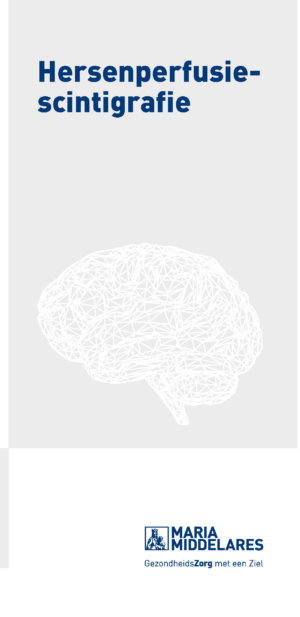Brain perfusion scan
What is it?
What is it?This test visualises the blood flow in the different parts of the brain, which is indicative of the functioning of those specific regions. Among others, it is applied in the diagnosis of dementia but also after brain trauma, brain infarction, etcetera.
You can find more information in the leaflet at the bottom of the page.
Test procedure
Test procedurePregnancy and breastfeeding
Are you pregnant or do you think you may be pregnant? Or are you breastfeeding? Please tell the physician before the injection. The test will not be performed if you are pregnant. If you are not sure whether you are pregnant or not, the test will be postponed until you are certain.
If you are breastfeeding, make sure to discuss this with the physician before the test. You will receive additional instructions about how to avoid unnecessary radiation exposure to your child.
Preparation
You do not need to be fasting for this test. Talk with your physician about whether you may take your regular medication.
Procedure
A small quantity of radioactive material is administered by an intravenous injection in the arm. After at least 30 minutes, the liquid will be absorbed by the brain and images of the brain can be taken. During the test, you will lie with your head in a headrest and images are taken for 35 minutes. It is important that you do not move your head during the test. Unless you are an inpatient, you may resume your normal activities afterward.
Radiation and safety
Radiation and safetyThere are essentially no side effects: the injected product causes no abnormal sensations and only in very rare cases causes (very mild) allergic reactions. The injected radioactive material does constitute a dose of radiation, but it is very small (about as much as for a regular CT scan).
The quantity of radiation that you are exposed to during the test is not higher or lower depending on the number of images taken. The radioactive material will have disappeared almost completely from your body 12 hours after the test.
It is recommended that children younger than the age of 6 do not sit on your lap for more than half an hour during the first 12 hours after the test. Playing, feeding, changing sheets and nappies and other daily activities are no problem.
Prolonged contact (longer than one hour) in close proximity (less than one metre) with pregnant women during the first 12 hours should be avoided too.
Results
ResultsWe prepare a report of the test. That report and the images are digitally available to the physician who requested the test.
Leaflet
LeafletOnly available in Dutch:

Hersenperfusiescintigrafie
DownloadCentres and specialist areas
Centres and specialist areas
Latest publication date: 16/05/2024
Supervising author: Dr Van Den Bossche Bieke



